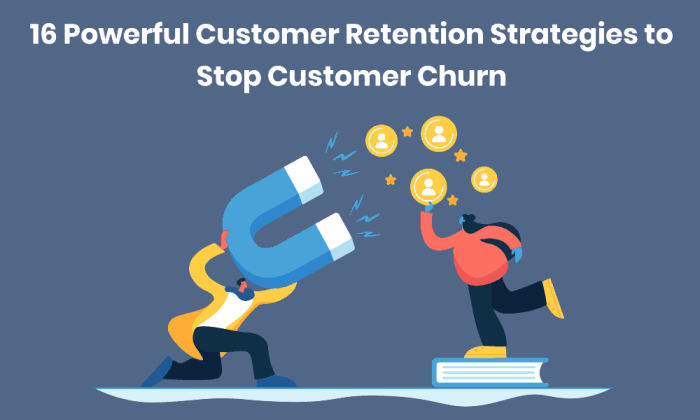Customer Retention Strategies: How CRM Can Help Reduce Churn Rates – In today’s competitive business landscape, customer retention is crucial. This article explores how Customer Relationship Management (CRM) can help businesses identify customer needs, personalize interactions, improve customer service, and create loyalty programs to reduce churn rates and enhance customer lifetime value.
Customer Retention Strategies
In today’s fiercely competitive business landscape, customer retention has become paramount for organizations to sustain growth and profitability. Retaining existing customers is far more cost-effective than acquiring new ones, as it costs five times more to attract a new customer than to retain an existing one.
Customer churn, the rate at which customers discontinue doing business with a company, can significantly impact a company’s bottom line. Identifying and addressing the factors that contribute to customer churn is crucial for developing effective retention strategies.
Factors Contributing to Customer Churn
Understanding the reasons why customers leave is essential for developing targeted retention strategies. Some common factors that contribute to customer churn include:
- Poor customer service:Unresponsive or unhelpful customer support can lead to frustration and dissatisfaction.
- Lack of value:Customers may switch to competitors if they perceive better value for their money elsewhere.
- Product or service issues:Defects, bugs, or performance problems can damage customer satisfaction.
- Price sensitivity:Customers may be price-sensitive and switch to cheaper alternatives.
- Competition:Aggressive marketing campaigns or superior offerings from competitors can entice customers to switch.
Using CRM to Identify Customer Needs

Customer relationship management (CRM) systems play a crucial role in helping businesses understand their customers’ needs and preferences. By gathering and analyzing customer data, businesses can gain valuable insights into customer behavior, preferences, and pain points. This information is essential for developing targeted marketing campaigns, improving customer service, and ultimately reducing churn rates.
There are several methods for collecting customer feedback, including surveys, feedback forms, social media monitoring, and customer interviews. Businesses should use a combination of these methods to get a comprehensive view of their customers’ needs. It is also important to use this data to make improvements to the customer experience.
For example, if a business finds that customers are frequently complaining about a particular product or service, they can use this feedback to make improvements and increase customer satisfaction.
Customer Feedback Methods
- Surveys: Surveys are a great way to collect customer feedback on a specific topic. They can be conducted online, via email, or in person.
- Feedback forms: Feedback forms are a simple way to collect customer feedback on a specific product or service. They can be placed on a website, in a store, or at a trade show.
- Social media monitoring: Social media monitoring can be used to track customer feedback on social media platforms. This can be a valuable source of feedback, as customers are often more likely to share their thoughts and opinions on social media.
Customer retention strategies are crucial for businesses to reduce churn rates and boost profitability. CRM (Customer Relationship Management) systems play a vital role in this by providing insights into customer behavior and preferences. By leveraging CRM, businesses can identify at-risk customers, personalize marketing campaigns, and enhance customer service.
These efforts contribute to building stronger customer relationships and reducing the likelihood of customers switching to competitors. Moreover, CRM systems offer advantages over ERP (Enterprise Resource Planning) systems in terms of customer-centricity and flexibility. To explore the benefits of CRM versus ERP in more detail, refer to the insightful article advantage crm vs erp.
- Customer interviews: Customer interviews are a great way to get in-depth feedback from customers. They can be conducted over the phone, via video conference, or in person.
Personalizing Customer Interactions
Personalizing customer interactions involves tailoring marketing campaigns and customer service strategies to meet the unique needs and preferences of individual customers. This enhances customer satisfaction, loyalty, and retention rates.
CRM (Customer Relationship Management) systems facilitate personalization by collecting and analyzing customer data, including demographics, purchase history, preferences, and engagement history. This data allows businesses to segment customers into targeted groups and tailor their interactions accordingly.
Benefits of Personalized Customer Interactions
- Increased customer satisfaction and loyalty
- Improved customer engagement and response rates
- Enhanced brand perception and differentiation
- Increased sales conversions and revenue
Examples of Personalized Marketing Campaigns
Personalized marketing campaigns leverage CRM data to deliver targeted messages and offers to customers based on their interests and behaviors. For example:
- Sending personalized email campaigns with relevant product recommendations
- Displaying tailored ads on websites and social media based on browsing history
- Offering exclusive discounts and promotions to loyal customers
Examples of Personalized Customer Service Strategies
Personalized customer service strategies use CRM data to provide tailored support and assistance to customers. For example:
- Providing proactive customer support based on customer behavior and preferences
- Offering personalized recommendations and solutions based on purchase history
- Providing personalized follow-up after a purchase or interaction
Using CRM for Customer Segmentation
Customer segmentation is the process of dividing a customer base into smaller, more manageable groups based on shared characteristics. This allows businesses to develop targeted marketing and retention strategies that are tailored to the specific needs of each segment.
CRM systems can help businesses segment customers based on a variety of factors, including demographics, behaviors, and preferences. This information can be used to create customer profiles that include information such as:
- Age
- Gender
- Location
- Purchase history
- Website behavior
- Email preferences
By understanding the unique needs of each customer segment, businesses can develop marketing and retention strategies that are more likely to be effective. For example, a business might target a segment of customers who are interested in a particular product with a special offer or promotion.
Customer segmentation is an essential part of any customer retention strategy. By using CRM systems to segment customers, businesses can develop targeted marketing and retention strategies that are more likely to be effective.
In the dynamic landscape of customer engagement, Customer Relationship Management (CRM) has become an indispensable tool for businesses seeking to retain loyal customers and minimize churn rates. By leveraging mobile CRM solutions, organizations can extend their reach and enhance customer experiences on the go.
As detailed in The Evolution of Mobile CRM: Enhancing Customer Engagement on the Go , these advancements empower businesses to nurture customer relationships and gather valuable insights, ultimately driving retention strategies and fostering long-term brand loyalty.
Measuring the Impact of CRM on Customer Retention
To evaluate the effectiveness of CRM systems in reducing churn rates, businesses can track and analyze key metrics. These metrics provide valuable insights into customer behavior, satisfaction, and engagement, enabling businesses to identify areas for improvement.
If you’re looking to up your customer retention game, CRM (Customer Relationship Management) is your secret weapon. CRM gives you the tools to understand your customers’ needs, personalize their experiences, and build lasting relationships. By implementing effective CRM strategies, you can drastically reduce churn rates and keep your customers coming back for more.
Customer Lifetime Value (CLTV)
CLTV measures the total revenue a customer is expected to generate over their lifetime. It considers factors such as customer spending habits, churn rate, and average purchase frequency. By tracking CLTV, businesses can assess the impact of CRM initiatives on customer loyalty and profitability.
Churn Rate
Churn rate represents the percentage of customers who discontinue doing business with a company within a specific period. CRM systems help identify customers at risk of churning by analyzing their interactions, purchase history, and feedback. Tracking churn rate allows businesses to measure the effectiveness of retention strategies and make adjustments accordingly.
Customer Satisfaction (CSAT)
CSAT surveys gather feedback from customers to measure their satisfaction with products, services, and interactions with the company. CRM systems can automate CSAT surveys, collect responses, and analyze data to identify areas where customer experience can be improved. High CSAT scores indicate increased customer loyalty and reduced churn risk.
Net Promoter Score (NPS)
NPS measures customer loyalty by asking customers how likely they are to recommend a company’s products or services to others. High NPS scores indicate satisfied customers who are more likely to remain loyal and generate positive word-of-mouth.
Customer Engagement
Customer engagement metrics track interactions between customers and a company, such as website visits, social media engagement, and email open rates. High engagement levels indicate active customers who are more likely to be retained.
Emerging Trends in Customer Retention

The customer retention landscape is constantly evolving, driven by advancements in technology and changing customer expectations. Businesses must stay abreast of these emerging trends to remain competitive and provide exceptional customer experiences.
Customer Retention Strategies: How CRM Can Help Reduce Churn Rates is a crucial aspect of business growth. Implementing a robust CRM system can effectively manage customer relationships, track interactions, and identify potential churn risks. In addition, integrating what is ERP in company with CRM can further enhance customer data management, streamline processes, and improve overall business efficiency.
This synergy allows businesses to proactively address customer needs, reduce churn rates, and foster long-term customer loyalty.
One notable trend is the increasing adoption of artificial intelligence (AI) and machine learning (ML). AI-powered chatbots and virtual assistants can provide personalized and real-time support, enhancing customer satisfaction and reducing churn. ML algorithms can analyze customer data to identify patterns and predict churn risks, enabling businesses to proactively address potential issues.
Personalization and Omnichannel Experiences
Personalization has become a key differentiator in customer retention. Businesses are leveraging data analytics to understand individual customer preferences and tailor their interactions accordingly. Omnichannel experiences, where customers can seamlessly interact with a business across multiple channels, are also gaining prominence.
Implementing a CRM can be a game-changer for businesses looking to reduce churn rates and enhance customer retention. By leveraging data and insights, CRMs empower businesses to tailor personalized experiences and proactively address customer concerns. For small businesses navigating the choice between CRM and ERP, this article provides valuable insights to help make an informed decision.
Ultimately, understanding the specific needs of your business and leveraging the power of CRM can drive customer loyalty and long-term growth.
By providing consistent and personalized experiences across all touchpoints, businesses can build stronger relationships with their customers.
Data-Driven Decision-Making, Customer Retention Strategies: How CRM Can Help Reduce Churn Rates
Data-driven decision-making is essential for effective customer retention. Businesses are using customer relationship management (CRM) systems and other data analytics tools to track customer behavior, identify trends, and make informed decisions. This data-centric approach enables businesses to optimize their retention strategies and improve customer outcomes.
Customer-Centric Culture
Building a customer-centric culture is paramount for long-term retention success. This involves putting the customer at the heart of all business decisions and empowering employees to go the extra mile to meet customer needs. Businesses that foster a customer-centric culture are more likely to retain customers and drive business growth.
Last Point

By leveraging CRM systems, businesses can gain valuable insights into customer behavior, tailor marketing campaigns, and provide exceptional customer experiences. As a result, they can foster customer loyalty, reduce churn, and drive business growth in the long run.
Query Resolution: Customer Retention Strategies: How CRM Can Help Reduce Churn Rates
What is customer churn?
Customer churn refers to the rate at which customers stop doing business with a company over a specific period.
How can CRM help reduce churn?
CRM systems provide businesses with a centralized platform to track customer interactions, identify customer needs, and personalize marketing and service strategies to reduce churn.
What are the key metrics for measuring CRM effectiveness in reducing churn?
Key metrics include customer lifetime value, customer satisfaction, and churn rate.





